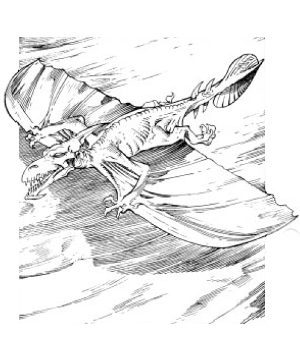

2405

| Climate/Terrain: | Sea of Silt, Inland silt basins |
|---|---|
| Frequency: | Uncommon |
| Organization: | Pack |
| Activity Cycle: | Any |
| Diet: | Carnivore |
| Intelligence: | Semi- (2-4) |
| Treasure: | Nil |
| Alignment: | Neutral |
| No. Appearing: | 2-8 |
| Armor Class: | 3/6 |
| Movement: | 3, Fl 30 (B), Glide 24 (E) |
| Hit Dice: | 4 |
| THAC0: | 17 |
| No. of Attacks: | 3 |
| Damage/Attack: | 2-8/2-8/1-4 |
| Special Attacks: | Surprise, 2� damage on a charge |
| Special Defenses: | Nil |
| Magic Resistance: | Nil |
| Size: | M (8’ wingspan) |
| Morale: | Average (9-10) |
| XP Value: | 420 |
Psionics Summary
| Level | Dis/Sci/Dev | Attack/Defense | Score | PSPs |
|---|---|---|---|---|
| 1 | 2/1/3 | —/M- | 11 | 45 |
Telepathy — Sciences: nil; Devotions: life detection, mind blank.
Psychokinesis — Science: flight; Devotion: control sound.
Note: flight — 3 PSPs/round, Mv 30 (B)
The razorwing hides under the silt and bursts out of the sand to slash at creatures flying above it. It is a vicious carnivore, and packs of razorwings have brought down creatures much larger than themselves.
The razorwing is a small-bodied slate gray creature that looks a bit like a small pterrax. It has bone white edges on its wings which are very sharp.
A razorwing is able to communicate with others of its kind. It does not have a language, but uses its power of controlled sound to communicate when prey is nearby.
Combat: The razorwing lies in wait for its prey just under the silt. It is very light weight, and when it spreads its wings out it can actually rest on, or just below, the surface of the silt. When it senses prey, it explodes out of the silt and climbs to slash at its prey. The razorwing uses a form of telekinetic flight to achieve its great speed and lightning-quick attack. A razorwing’s sudden attack causes a -2 penalty to its opponent’s surprise rolls.
A razorwing cannot fly normally, the razor edges of its wings being too hard to allow them to bend more than a few inches. It can glide, but for actual flight it uses its psionic flight power. The razorwing has a limited amount of PSPs and cannot maintain its accelerated flight for long. The favored attack form of a razorwing is flying up behind a creature and slashing at its wings, if any. On the following round the razorwing climbs above its prey and glides down to attack. The razorwing can also hover in the air using its flight power, but cannot maintain this for long. A razorwing can use its psionic flight powers for only eight rounds before it must glide to the silt and rest. The razorwings try to spend as much time gliding as they can, to stretch out the time they can spend in the air. A razorwing almost never hovers to melee, as it is much more vulnerable when not moving. A razorwing is AC 3 when in flight, but only AC 6 when hovering or grounded.
The razorwing can attack with its bite and with both of its sharp wing edges. However, unless the creature is large, like a floater, the razorwing can only land one of its wing attacks per victim. If the initial attack is made with surprise, the razorwing causes double damage on its wing hits. It will also use its bite on a surprise attack, concentrating on crippling a flying opponent. Each wing attack does 2d4 points of damage, and the bite does 1d4 points of damage.
The razorwings fight well in small packs, taking advantage of the confusion caused by their numbers to glide in and attack from behind whenever possible. Indeed, a razorwing pack can be overwhelming, as they swoop in for attack after attack. Only if over half of the pack is downed will the rest fly off. Any fleeing razorwings use their remaining PSPs to climb as high as they can, and then glide away for miles. The wings are maneuverable enough to aid in gliding; the razorwing can glide up to a mile for every 200 feet of altitude it has. It always chooses to glide with the wind, unless such a direction would place it in danger. It has a maneuverability class of E when gliding.
The razorwing pack takes turns using their life detection, using controlled sound to warn the others of approaching prey.
Habitat/Society: The razorwings live and hunt in packs. They also never attack alone. There is a pack leader, usually the biggest female.
Razorwing young are born alive, high in the air. They immediately learn to glide or they do not survive.
Ecology: Razorwings are found in the Sea of Silt almost exclusively. There are reports of packs being sighted in the inland silt basins. The razorwing prefers to eat floaters above all else. By means of its life detection power, a razorwing can even differentiate between a floater and other kinds of prey.

◆ 1515 ◆